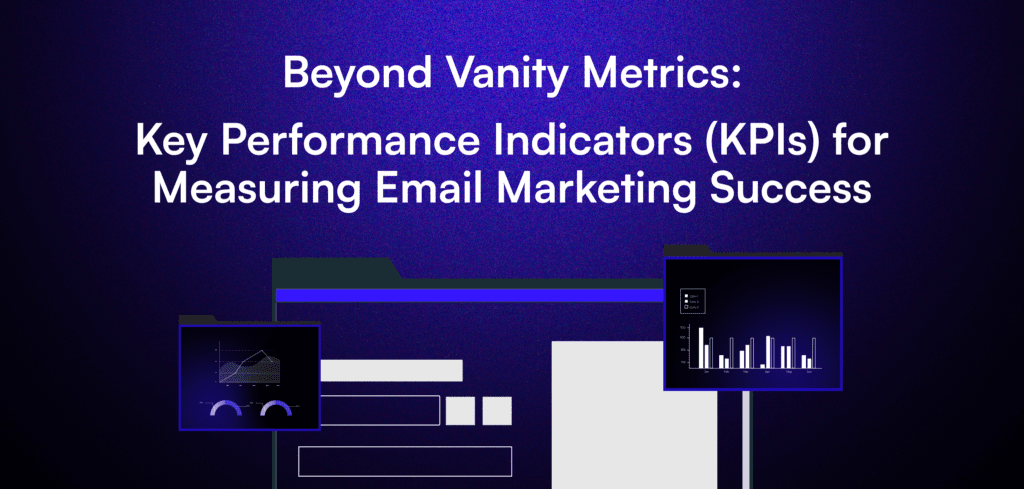Plus Tips On How To Improve Them!
Ever found yourself wondering why some emails are magnetic, pulling your audience in, while others flop straight to the recycle bin?
In email marketing, knowledge isn’t just power—it’s your biggest not-so-secret weapon. Imagine boosting your email open rates by just 5%. Sounds small, right? But oh, the impact it can have on your conversions could be explosive!
In this blog, we discuss the metrics you should keep an eye on to measure your email campaign performance, as well as actionable tips on how to improve these metrics.
But first, let’s look at the big picture.
Why Do You Need To Measure Your Email Metrics?
Well, that can be answered with a saying as old as time itself.
Because what gets measured gets managed—and what gets managed gets mastered!
Think of metrics as your marketing GPS. Without them, you’re just wandering in the wilderness, hoping to stumble upon success. But with them? You’re equipped with a precision map that guides every step towards your ultimate destination: skyrocketing growth.
Metrics light the path from where you are to where you want to be, giving you shortcuts and revealing pitfalls.
But here’s the real kicker: measuring your metrics allows you to pivot with purpose.

Understanding Vanity Metrics vs. Actionable Metrics
Not every metric needs your undivided attention.
Vanity metrics, though tempting with their often impressive figures, can be deceptive. They often offer little to zero real strategic value.
The true game-changers? They’re the actionable KPIs that directly connect with your core business objectives.
First, let’s take a look at vanity metrics.
What are Vanity Metrics?
Vanity metrics are surface-level numbers that may look impressive on paper but don’t provide meaningful insights into the true performance of your email campaigns. While it’s tempting to focus on these metrics, they often offer little to no strategic value.
Some common vanity metrics in email marketing include:
Total Email List Size
A massive list feels impressive, doesn’t it? But a huge crowd of disengaged subscribers can actually do more harm than good—negatively impacting your deliverability and sender reputation. When it comes to building an audience, quality trumps quantity – an engaged, relevant list will always outperform a bloated one filled with irrelevant contacts.
Number of Email Sends
Here’s an email marketing myth: more emails equal more results. Bombarding inboxes with excessive emails is a surefire way to trigger subscriber fatigue, high unsubscribe rates, and even spam complaints. The real key lies in quality content, relevance, and a strategic, well-timed cadence that provides value to your audience.
Email forward/share rate
Shares boost visibility, no doubt about it. But increased visibility alone doesn’t directly impact your bottom line or core business objectives. Your goal should be converting those new eyeballs into engaged, loyal, and revenue-driving customers. Shares are great, but they’re not the endgame.
Email Reply Rate
Replies feel like engagement, don’t they? But in reality, they’re frequently just noise – valuable feedback at times, but rarely translating directly into conversions, sales, or sign-ups. Don’t get distracted by the chatter when your focus should be on metrics that drive tangible business outcomes.

What are Actionable Metrics?
Now, let’s move on to the metrics that provide real valuable insights into your email marketing efforts.Understanding and refining key email metrics can turn a good campaign into an outstanding one. And there are two types of metrics: core email metrics and advanced email KPIs. These figures will reveal the true effectiveness of your emails.
Core Email Metrics
Core email metrics are essential indicators that provide insights into the basic performance of your email campaigns and help you gauge how well your emails are engaging recipients and driving actions. These metrics are fundamental for understanding the immediate impact of your marketing efforts.
Open Rate
Simply put, the open rate measures how many people are opening your emails. This figure is influenced by your subject line’s appeal and your sender’s reputation.
To boost this number, consider these strategies:
- Write irresistible subject lines that capture attention and spark curiosity. Regularly split-test different subject lines to see what resonates best with your audience.
- Additionally, optimize the timing of your emails by sending them when your subscribers are most likely to be checking their inboxes.
- And last tip, maintain a clean email list by removing inactive subscribers, which can help improve your overall engagement rates and sender reputation.
Click-Through Rate (CTR)
Once your email has charmed its way into being opened, the next mission is clinching that click. The click-through rate (CTR) measures how effectively your email encourages recipients to click on links and buttons within the email. It highlights which parts of your email, like offers or calls to action, truly grab the audience’s attention.
To enhance your CTR:
- Ensure your links are visible and enticing. Use buttons or standout text formats to make them easy to find.
- Keep your email content concise and compelling, focusing on delivering value that prompts readers to act immediately.
- Tailor your calls to action to be clear, specific, and unique, like “Save 20% Now” or “Get My Goodies,” to guide users towards the desired action smoothly.
Conversion Rate
What is your email’s endgame? Action.
The conversion rate measures how many clicks on your email lead to actual actions, like purchases, sign-ups, or subscriptions. It shows how effectively your email moves readers from interest to action.
To boost your conversion rate:
- Focus on delivering highly personalized content that addresses the specific needs and interests of your audience.
- Streamline your email design to make the navigation intuitive and the action steps clear.
- Ensure that every element in the email, from graphics to call-to-action buttons, is optimized for a smooth user experience.
Advanced Email KPIs
Advanced Email KPIs (Key Performance Indicators) delve deeper into the nuances of email marketing and measure more complex aspects such as bounce rates, list growth rates, unsubscribe rates, and spam complaints.
Think of these KPIs as your behind-the-scenes crew, working the levers and dials to fine-tune your campaign’s performance.
Bounce Rate
This metric refers to the percentage of email addresses in your campaign that did not receive your message because the emails were returned by the recipient’s mail server.
There are two types of bounces to consider: “hard” bounces, which occur when the email address is invalid or the email server has permanently blocked delivery, and “soft” bounces, which happen due to temporary issues like a full inbox or a server being down.
A soaring bounce rate might be sounding the alarm bells for your campaign, signaling issues with email validity or your server’s reputation.
List Growth Rate
This measures the rate at which your email list is growing. It shows the increase in subscribers over a specific period, accounting for new subscriptions minus unsubscribes and email bounces. This rate is crucial for gauging the effectiveness of your list-building strategies such as lead magnets and the overall engagement level of your audience.
A climbing list growth rate signifies a booming interest and engagement.
Unsubscribe Rate and Spam Complaints
The Unsubscribe Rate shows the percentage of recipients who opt out of your email list after receiving an email. A high unsubscribe rate can indicate that your content isn’t meeting subscriber expectations or that they find your emails irrelevant. (Ouch!)
On the other hand, the Spam Complaints tracks the number of times your emails are marked as spam. Keeping spam complaints low is crucial for ensuring your emails reach their intended inboxes.
Facing these metrics can be daunting, but it’s crucial. They’re the truth-tellers when your content strategy might be veering off course, coming off as too aggressive or missing the alignment with your audience’s expectations.
Refine your tactics by syncing your content more precisely with what your subscribers are seeking and by maintaining a respectful communication cadence or frequency.
So… what now?
Measuring the right metrics is the key to unlocking the true potential of your email marketing campaigns. By focusing on actionable KPIs, you gain invaluable insights into what’s working, what’s not, and where you can optimize.
Remember, vanity metrics might look impressive at first glance, but they’re often just smoke and mirrors.
Don’t get distracted by superficial numbers that don’t drive real business impact. Instead, zero in on the metrics that align with your core objectives and provide a clear picture of your audience’s engagement, interests, and readiness to take action.
With these insights, you’re not just running a good old boring email campaign; you’re using data to revolutionize your emails and your brand. Metrics are not just mere measurements—they’re the compass that guides your strategic decisions.
Great read, eh? Well, we’re just getting started! Subscribe below to get updates when new blogs are live!


